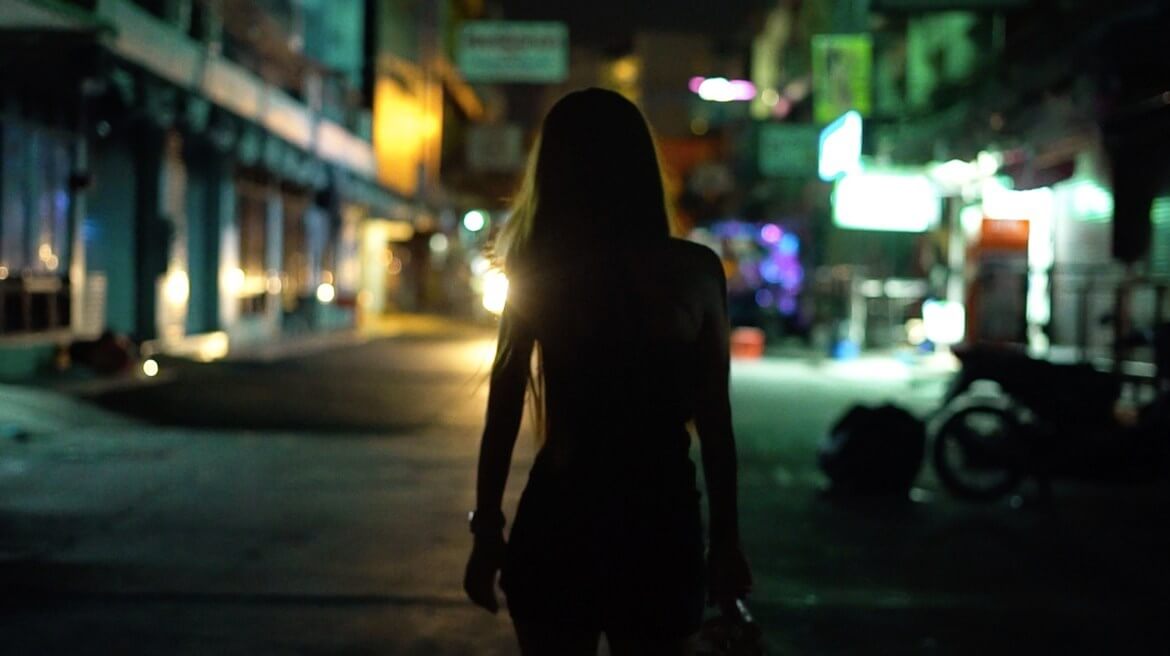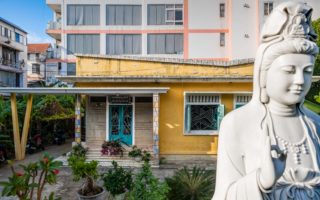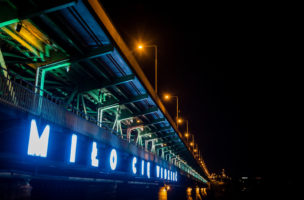Support Hidden Compass
We stand for journalism, science, history, and hope. Make a contribution to Hidden Compass and stand with us.
As I land in Thailand, my understanding of prostitution is limited to movie depictions, cursory research about sex trafficking, and glimpses of women on street corners: in other words, it is distant and limited. Pattaya is about to change that.
Upon my arrival, Bangkok’s Suvarnabhumi Airport presents an enchanting, cosmopolitan picture of Thailand. The terminal is massive and modern, studded with high-end retail stores where travelers mill about in silk. Photographs of Buddhist temples and children patting weathered elephant trunks plaster the arrivals area. But at the airport’s exit, the signs contradict each other.
“Welcome to the Land of Smiles!” one reads.
Next to it, another says: “Child prostitution is illegal. Report suspicious activity.”
In fact, all forms of prostitution are illegal in Thailand, though the country is infamous for cheap and readily available sex. Which is exactly why I’m here — not for the sex, but to write a story about it. Or rather, to write a story about the people involved. My destination is Pattaya, a coastal city two hours south of Bangkok. It’s the unofficial sex capital of Thailand, which is itself the prostitution hub of Southeast Asia. That makes Pattaya — arguably — the prostitution hub of the world.
During this trip, I will visit Pattaya’s red light district to meet the women and ladyboys (the local term for transsex workers) who work there — an activity that feels both voyeuristic and intimidating. I’ve heard most of them get into the industry because it pays better than any job in rural villages. Others are sold into the work, often by their own families, or conned into prostitution after being promised a job at a mall or restaurant. Besides this limited knowledge, my ideas about sex workers are fuzzy, the women in them filling vague stereotypes about desperation and exploitation. My imagination supplies me with scenes of blank-faced figures soliciting from the shadows.

Before arriving in Thailand, for writer Annelise Jolley prostitution was a distant concept. Sex workers were nameless, faceless people who solicited from the shadows. Pattaya, she hoped, would make things clearer. PHOTO: PJ ACCETTURO.
This is, in part, why I travel. From far away, people are undefined shapes. Only when we come closer can we see them clearly.
~~
Once upon a time, Pattaya matched the images found on postcards. There was ocean like a watercolor painting, palm trees with frothy branches and fishing boats painted yellow and green. During the Vietnam War, G.I. soldiers on holiday found Pattaya to be an agreeable getaway. They enjoyed the city for all its pleasures, first arriving with prostitutes and then paying local girls. Then, rather than returning home after the war, many American soldiers simply stayed in Southeast Asia. As the sex industry grew, Pattaya transformed. It morphed from beach village to party town, complete with go-go bars, karaoke dives, and brothels. Today the city is either a debauchery destination or a place to avoid, depending on what kind of vacation you’re looking for.
On the night of my arrival, we park in the heart of Pattaya, beside a half-mile strip of clubs and bars, most concealing brothels upstairs. Dianna, our guide, turns from the front seat to face me and Haley, a photographer. Dianna is expressive and charismatic with a decisive manner of speaking, saying “yes” instead of “yeah” and nodding for emphasis. In 2015, she left her job as a Hollywood hairstylist to start Shear Love. The vocational beauty school employs women who want to get out of sex work, paying them a living wage while training them in employable skills. Each day, Dianna rides her motorbike to the Shear Love salon, where she teaches a dozen girls how to cut, color, and style hair. The girls have become her friends and her family.
Dianna meets most of her students in Pattaya’s red light district, befriending them at bars before inviting them to join Shear Love. She is well versed in street etiquette and briefs Haley and me: don’t stare, don’t take pictures of the girls, and ignore the sex menus offered by bar employees. House music thumps against our car windows.
“All right, let’s go,” Dianna says, stepping out of the car.
She leads the way beneath a neon archway, where a halogen-lit portrait of Thailand’s king presides over the words “Walking Street.”
~~
The night’s heat sits on my neck and shoulders as we approach the stretch of bars. Children perform contortions on the sidewalk while their pimps collect tips. In front of the bars, Caucasian and Middle Eastern men traveling alone or in pairs circle girls clad in platform heels and miniskirts and labeled with numbers. Most of the bar workers appear to be from Southeast Asia, with the exception of several Eastern European women in the doorway of a club called “Crazy Russian Girls.”
This is, in part, why I travel. From far away, people are undefined shapes. Only when we come closer can we see them clearly.
Colored lights and club music and the smell of sewage washes over me as I try to catalog Walking Street’s bizarre scene: a cart selling coconut ice cream, a woman simulating a blowjob to a passerby, Chinese tourists with selfie sticks, police standing idly on corners, teenage girls haggling with middle-aged men over the value of their body.
Most girls appear to be around my age or younger: early to mid-twenties, or in their late teens. Up and down Walking Street they share noodles from Styrofoam containers, pass phones back and forth, and squat on stilettos as they chat during breaks, squeezing each others’ wrists with the thoughtless intimacy of college roommates or sisters. When a customer approaches their faces shift, laughter receding and replaced by smiling masks.

Women in platform heels and short skirts advertise on the streets of Pattaya. PHOTO: PJ ACCETTURO.
Conservative estimates count around 250,000 sex workers in Thailand, but some NGOs believe the number is closer to 2 million. If that’s accurate, then three percent of Thailand’s population sustains an industry that generates ten percent of the country’s GDP. Much of that money is sent home to struggling families: one report by the International Labor Organization found that sex workers sent home $300 million a year to rural areas, “more than any government development project.”
Far from the exception, Pattaya sets in plain view something that exists all around us: the limited and often exploited choices of society’s vulnerable members.
Drive northeast from Pattaya and you’ll reach Isaan, the country’s largest and poorest region. The overwhelming majority of girls who work in Pattaya’s bar-and-brothels come from this rural, poorly-educated sector. Though most of Isaan’s families are subsistence farmers, it’s nearly impossible to make a living through farming due to unproductive rice paddies, sandy soil, and flat terrain that’s prone to drought or — when it does rain — flooding. Because Thai culture expects daughters to care for parents, girls as young as 14 look for paying jobs. But with little education and non-existent employment opportunities in their villages, girls from Isaan often move south — where they can make the kind of money they’d never see at home.
Pattaya’s sex industry is one result of rural poverty. Yet the city’s prevalence of prostitution is not just because of Isaan, nor is it particular to Thailand. Sex work takes place in every city, and in some countries — Belarus, Central African Republic, China, and Iran, to name a few — sex trafficking is common practice. Far from the exception, Pattaya sets in plain view something that exists all around us: the limited and often exploited choices of society’s vulnerable members.
~~
In the daylight, Beach Road offers clues to the allure the city might once have held. Pale water laps at the shore and palms fringe the sand, which is sprinkled with used condoms and glass bottles. There seems to be only one temperature in the city during April: sweltering. We find shelter under a canopy of ratty umbrellas crammed along the shore. A waiter hurries over to take our order and when he leaves to retrieve our fried rice and mango juice, Dianna leans forward.
“You could have asked him for anything,” she says. Her eyes widen as she speaks. “I’m not kidding. Drugs, a man, a woman, a kid. Employees all over the city — regardless of if they work at a hotel, a restaurant, or a brothel — are there to give visitors whatever they want.”
Remembering the signs in the airport Haley says, “But prostitution is illegal. Can’t they get in trouble?”
“You saw those cops on Walking Street. They’re bribed to keep quiet.”
Despite Pattaya’s blatant exploitation, NGOs haven’t flocked here the way they have to the north — to Chiang Mai or Chiang Rai —or to Bangkok, home to well-known anti-trafficking groups like NightLight International. Dianna’s organization, Shear Love, is one of just 11 groups working to prevent trafficking in Pattaya. Of these, only three do any kind of bar outreach.
I ask Dianna about this vacuum. “Why aren’t nonprofits coming here?”
“This city is so dark. It’s hard to feel hopeful about Pattaya’s future when so many people are being sold on a daily basis. A lot of people feel like Pattaya is a lost cause.”
“Do you feel that way?”
Dianna is nodding even before she answers. “Sometimes, yes. We have a dozen students in our program — and that’s amazing — but it can be very daunting when you look at the statistics. Thousands of women and children and ladyboys are being exploited on a daily basis here.”
“But some women choose to come here and to work, right? They move to Pattaya to send money home to their families?”
Dianna pauses to locate the words. Finally, she sighs, an exhale that is heavy with frustration and compassion.
“It’s a choice, but it’s not a choice.”
~~
This evening, we are scheduled to have dinner with three Shear Love students: Fai, Pim, and Hom. Earlier in the day, Dianna told us that she was worried about Fai, who had been skipping classes and acting cagey. Not all of the girls in the program leave the bars right away, and Dianna suspected Fai still worked her night job. At 19, Fai already has one young son from a john — the term for male customers.
As her car slides up to the curb outside the restaurant, Dianna checks her phone and slumps.
“Fai’s not coming,” Dianna tells us. “She just found out she’s pregnant.”
“Does she know who the father is?” Haley asks.
“Another customer.”
Dianna stares at her phone for another minute before tapping out a long text, telling her student she loves her, asking her to please call as soon as she can.
Inside the restaurant, we find Pim and Hom — best friends. Their hair is streaked with purple and green, respectively — that week’s lesson was on coloring. Pim, who is pretty and effusive, worked in the red light district for years to send money home to Isaan. Hom is shyer and overweight, and covers her mouth when she laughs. She was trafficked for labor, forced to work inhumane shifts at Pattaya’s downtown mall.
We sit at a wooden picnic table under leafy branches, prayer flags, and hanging lights. A stray cat threads through our legs. Pim orders for the table, grinning at the waiter and at us. She was the first girl Dianna met in the bars. The two of them spent Christmas together Dianna’s first year in Thailand, and a picture of their grinning faces lights up the wallpaper on Dianna’s phone. When the food arrives, Pim holds out her hand for our bowls and ladles noodles and meat into them. Haley tells her that she is vegetarian and Pim nods vigorously, scooping more chicken into Haley’s bowl.
Pim has enviable cheekbones and a laugh that ripples. When Dianna told her about Shear Love, Pim didn’t need much convincing to join the beauty school; she was tired of sleeping with customers by then and had begun challenging johns to drink-offs to avoid taking them upstairs. “Whoever takes more shots wins,” Pim would tell customers across the bar. They’d look at her — wide smile, guileless eyes, a sheet of long hair — and pick up a glass. After several months of this game, Pim was a formidable drinker. They’d take turns shooting tequila — six shots, seven shots, nine. Her customers always fell before she did, though they couldn’t see her gripping the counter beneath the bar that separated them. She gained 20 pounds during this time but made it through her final weeks in the red light district without taking a man upstairs.
“I still so chubby!” she moans during dinner. “I don’t fit into my pants!” She slaps her thighs and dissolves into giggles, leaning into Hom’s shoulder as they both shake with laughter.
~~
It’s 10 p.m. and we’re back in the red light district, this time a half-mile away from Walking Street on a narrow road called Soi 6. Soi 6 is just a handful of blocks, but dozens of bars and brothels are packed into the narrow passage. Cars can barely squeeze through, and the ones that do are held up by bar girls who tap long nails on the windows and stroke their crotches, inviting business.
“There are 90 bars on this single street,” Dianna tells Haley and me. “About 20 girls in each.” She watches our faces as we do the math, nodding as the number dawns on us. “1,800 women and ladyboys work on Soi 6.”

The buzzing few blocks of Soi 6 in Pattaya, Thailand where roughly 1,800 sex workers make their livings. PHOTO: PJ ACCETTURO.
Walking down the cobbled street, I read bar names like “Quicky,” “Horny Bar,” and “The Pussy Club.” Girls stand outside each establishment dressed as sailors, geishas, and nurses.
“Hey there, pretty ladies!” a girl in a tube top and a miniskirt calls to us as we pass by. When we smile and wave she covers her mouth and turns away. I think of Pim and the years she worked on Soi 6.
As on Walking Street, the men ambling down Soi 6 are mostly white, mostly middle-aged. Watching them, I am struck by their awkwardness. I had pictured Pattaya’s male customers as predatory, but many appear apprehensive. One gangly guy with a Thai escort on his arm seems alarmed at her proximity. Another approaches a pack of bar employees wearing an expression reminiscent of a teenager crossing the gym to ask a girl to dance.
Inside a bar called Siren, Dianna spots a friend. We step into the throbbing darkness and a blur of long hair and red lips rushes to hug us. Pulling away, a five-o-clock shadow on her chin becomes visible. Madee is a short and muscular ladyboy with small hands that she claps in front of her face when she laughs. Like the other employees, she wears a Snow White-inspired uniform: blue bra, tiny yellow skirt, a bow in her hair. She seems extremely happy to see us.
We order ourselves drinks, plus an extra for Madee, who joins us at a table. The bar’s mamasan — the local name for brothel madams — watches us from behind the counter, stroking a small dog stretched out next to the tumblers and pint glasses. Madee pats Haley’s arm and refreshes our water.
Madee’s English is poor and the music is shaking our seats, but she and I manage to yell out something like a conversation.
“SO WHERE ARE YOU FROM?” I begin.
“I FROM HERE!” she says.
“OH, FROM PATTAYA?”
“NO, NO. FROM THAILAND! NORTH OF HERE — ISAAN.”
This continues for a minute or so until we reach the limits of her English.
At one point, she disappears to her locker in the back and returns with a new purchase: a set of eye shadow, which she shows to Dianna, explaining her process for layering and blending the colors. Madee isn’t interested in leaving sex work yet, but she and Dianna have bonded over beauty products and discussing Madee’s goals for the future. Other than the slight shadow of a beard beneath foundation, Madee’s makeup is flawless.
On what has to be one of the strangest nights of my life, I am dancing with Thai sex workers to American club music, spinning together in this dizzying mirrored room and swept up in playfulness.
Leaving Siren, we wander down the street, following Dianna’s lead. Our next destination is a one-room bar, completely pink. A low mirror rims the wall. We’re the only customers besides one man nursing a beer, so several of the girls rush over to greet us. We buy drinks for them and ourselves and they thank us with a flurry of bowing and hand pressing. They are all attentive, which is another way of saying they are good at their jobs.
An employee who can’t be more than 20 introduces herself, but I don’t catch her name.
“Rabbit,” she repeats in a strong accent, and then wiggles two fingers above each ear. “Like the bunny!”
Rabbit is tiny and wobbly in her chunky platform heels. Her long nails are pressed with Mickey Mouse images, which she models for each of us. Because it’s still early, business is slow.
A few girls take advantage of this lull in work to run down the street and pick up snacks from a food vendor. They return bearing paper plates loaded with crispy grasshoppers and crickets, which we all pinch into our mouths. Beyond the fact that we’re paying for their time with drinks, they seem genuinely happy to chat and share food. One girl, learning I share both her first name and her age, gasps and reaches for my hands.
“We are sisters!” she says, squeezing my fingers, and I have no response for this other than to squeeze back.
~~
The night rolls on and the bar is still empty, so we crank the music up and push chairs aside to make a dance floor. On what has to be one of the strangest nights of my life, I am dancing with Thai sex workers to American club music, spinning together in this dizzying mirrored room and swept up in playfulness.
I catch Haley’s eye across the room.
“First time for everything!” she shouts, shrugging.
An hour later, Rabbit leaves for the second floor. “I have to go upstairs now. Bye bye!” Her arm is already being tugged by a customer as she hugs each of us. They head to the back of the bar, where a small landing opens to stairs that lead to the second-floor rooms. The girls live in these rooms during the day and host customers in them at night. Small pairs of sandals rest neatly next to men’s shoes at the base of the stairs.
One by one the girls drift up the stairs as johns make their purchases. Eventually only Dianna and Haley and I are left, reflected in the mirrors.
We step out of the bar into the sultry night. The girls’ faces follow us: Rabbit’s round eyes, Madee’s dark chin, Pim’s wide smile, the girls’ ponytails and bubblegum lips. It’s nearing midnight, and Soi 6 is the epicenter of light and noise in the darkening city. Up and down the street neon bar signs blink. Seen from afar, they mingle in a blur of color. But when we get closer, letters crystalize into names. Passing beneath each one, they wash us in their light.
Annelise Jolley
Annelise Jolley is a San Diego-based journalist and essayist who writes about food, travel, and the terrain between.
Never miss a story
Subscribe for new issue alerts.
By submitting this form, you consent to receive updates from Hidden Compass regarding new issues and other ongoing promotions such as workshop opportunities. Please refer to our Privacy Policy for more information.



